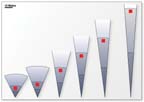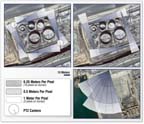Designing Automated Wide-area Surveillance Systems

Video analytics detects pixel changes in a camera’s field of view to track and classify activity. Sophisticated algorithms compare the pixel count and location of the anomaly to determine size, speed of movement, real world location and uses that information to classify it as a human, car, ship or other object. These algorithms are currently being refined to the point where they can detect specific behaviors – an unattended bag, a person loitering, or a vehicle slowing below normal speeds.
Most security professionals are at least aware of these new advances in video analytics. What is less understood is how video analytics fundamentally changes the way that surveillance systems are designed. End users and integrators that understand the basic differences between a standard CCTV design and one that incorporates video analytics can make smarter upfront decisions that will result in maximum surveillance coverage. They can also save themselves a bundle.

Analytic mindset
A standard CCTV design is focused around guards interacting with cameras. This means the camera image must provide a close-up view of the activity in order for the guard to have a high likelihood of recognizing the object. Typically, this requires the use of many cameras and lots of costly high-resolution pan/tilt/zoom (PTZ) cameras.Deploying cameras in conjunction with video analytics for wide-area surveillance requires a different mindset. In an automated wide-area design, the computer watches a smaller number of fixed cameras, while a smaller number of PTZ cameras are used for manual interrogation of events by guards.
The number of cameras required in an installation utilizing video analytics can be reduced, sometimes using less than half the number of cameras required by a regular CCTV installation. In addition, the camera locations can be consolidated resulting in a significant infrastructure cost savings.
Field of view and coverage
In a standard CCTV installation, users are primarily concerned about placing cameras to provide as close a view on activity as possible. For video analytics, the major factor for selecting and placing cameras is using cameras at the most extreme distance possible to cover the maximum area with a single camera. In order to minimize differences between different manufacturer’s cameras, automated wide-area design takes into account the field of view in degrees that the lens covers. The reason is that lens length is inconsistent between different camera manufacturers and CCD technologies, but the field of view is always reliable.
The illustration (Figure 1.) compares the coverage areas of wide and narrow field of view cameras. A wide field of view camera is going to cover more area close to the camera but a narrow field of view camera will cover far more distance. The shaded bands represent meters per pixel – with the far edge of the middle band representing the theoretical maximum detection of a human target by the computer. The double shaded area represents a very high-level certainty of detection of a human target.
For analytic detection, the term “pixels on target” is used to describe the likelihood that the computer can detect an object. The overall image is made up of thousands of pixels. Pixels on target is the number of pixels required to accurately detect an object within that image. The larger number of pixels, the better the recognition. For object detection and tracking, some analytics are accurate to four pixels on target, but a cautious estimate designs for ten pixels on target for detecting and accurately classifying a human.
In a standard CCTV design, camera field of view must take into account that humans need to see details. For that, the camera is useful for perhaps halfway through the double shaded area. This underscores the immediate difference between CCTV design and video analytics: The computer can vastly outperform the human.
Efficient camera usage
Understanding the threat is the most fundamental rule for automated wide-area surveillance design. Randomly putting in cameras and trying to cover as large an area as possible is expensive and may not address the real threat. Coverage should be maximized in high-risk areas and blind spots should be recognized and covered, including the holes underneath the cameras, between the camera’s location and where it actually first sees the ground.The capabilities of video analytics allow much more effective use of cameras than in a traditional CCTV installation. In traditional CCTV installations, the camera is pointed directly at the area under surveillance. In an analytic design pointing cameras down the line can cover a much larger area.
Good analytic designs use the longest angle possible. I affectionately call this the “sandwich” rule. See Figure 2. The idea is that a loaf of bread can be sliced vertically to make a lot of tiny sandwiches or it can be sliced horizontally right through the middle to make one big efficient sandwich. Cameras can be used most effectively the same way, looking along coverage areas.
Blind spots are another issue to consider when designing for efficient camera usage. A lot of areas look straight on a map, but on the ground there are rolling hills and trees that create blind spots. It’s the old rule: measure twice, cut once. Line of sight should always be verified with boots on the ground to insure optimal camera usage.
There are a lot of trade offs when making decisions about camera height. A higher camera means better detection capabilities and fewer obstructions but also creates a larger blind spot beneath the camera. Lowering the camera height reduces the blind spot, but it is easier for that camera to be obstructed. Extremely high camera placement is expensive and prone to vibration, while camera placement that is too low makes it vulnerable to damage or theft. The rule of thumb is that camera height is usually between 10 and 30 meters, but this can change if there is the potential for obstruction or to save money by using an existing stable mount location.

Sample design configurations
There is a popular CCTV design for securing a large perimeter that consists of cameras placed at specific intervals, looking directly out from the perimeter or with multiple preset views. So for every camera, there must be a pole, fiber, trenching and camera mountings. This design provides a large coverage area but it guarantees high infrastructure costs.The number one way to lower costs is to reduce the pole and camera counts. A building already has communication and provides sufficient camera stability. A design mount using existing buildings reduces the infrastructure and installation costs, even to the point that it is often still more cost effective to add additional cameras to cover the same area.
The illustrations above show several simple designs utilizing fixed cameras with analytic capabilities coupled with PTZ cameras for automated or manual interrogation by guards. These designs maximize coverage, eliminate blind spots, and could be used for ports, airports, industrial complexes, or corporate campuses. Proper selection of camera and lens to meet designed fields of view, and therefore range, allow for coverage distances of 150m to 2.5km and higher. Every facility has a unique profile, so basic designs need to be iterated upon for each individual case. For instance, airports have FAA restrictions on pole heights and locations. At ports, containers are often moved in and out of areas creating possible obstructions for cameras placed in the interior of the site.
Design with the end in mind
There are a host of issues to consider when deploying video analytics – networking, camera choice and integration with other systems, such as DVRs, access control, or smart fences. However, understanding some of the basic design techniques to maximize video analytics is the first step in automating wide-area surveillance.With a good design that takes full advantage of the capabilities of video analytics, users can match or even beat the cost of a standard CCTV installation. The return on investment from an automated surveillance system is immeasurable – both in terms of the increased productivity for the security staff and the improvements in overall security at the site.
Looking for a reprint of this article?
From high-res PDFs to custom plaques, order your copy today!








